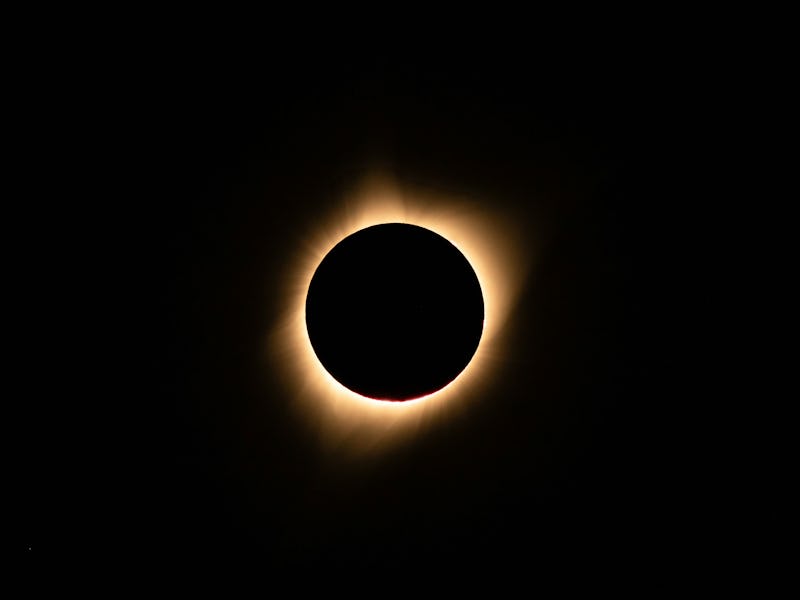An Astronomer Reveals the Hidden Trick to Taking the Ideal Eclipse Photo on Your Phone
Astronomer Douglas Duncan reveals how to take the best shot possible.

If you’ve never seen a total solar eclipse, University of Colorado Boulder astronomer Doug Duncan has some advice about photographing the big moment: Don’t.
That’s surprising advice coming from the developer of the SolarSnap app, a camera app designed specifically for taking pictures of solar eclipses. But he says if you’ve never seen a total eclipse before, you’ll want to be in the moment.
“A photo of totality is neat, but it's like a photo of the Grand Canyon: If you've ever seen the Grand Canyon, it's so much more than a picture of it,” Duncan tells Inverse.
During several recent total eclipses, Duncan noticed people juggling their smartphones, their eclipse glasses, and their camera apps.
“It's kind of hard to hold your phone, hold a pair of eclipse glasses in front of your phone, and with your third hand, control the camera,” says Duncan. But if you are keen on taking a photo during the eclipse, he recommends sticking to the period of partial eclipse. Here’s how to take the best shot possible.
How to Take the Best Eclipse Pics
Protect your optics
Looking directly into the Sun can burn your retinas and it can do the same thing to your camera (and a smartphone has a 0 percent chance of healing afterward). You can purchase a smartphone camera cover like the SolarSnap kit, which Duncan created, or you can buy a fancier solar filter at most camera stores. Improvising is also an option; you can hold the lens of your eclipse glasses over your phone’s camera, as long as you make sure the camera is covered (and that you’re not covering the lens with the glasses’ frame, not that I’m confessing to any such mistake).
Put your phone in landscape mode
Remember: You’ll need to take your eclipse glasses off to see your phone screen (or anything besides the bright glowing disk of the Sun itself), so you’ll have to make sure that your phone is shielding your eyes from the Sun. For the most effective shading, turn your phone horizontally. This will also block the Sun’s glare so the screen is easier to see.
Practice on indoor objects before eclipse time.
Don’t worry about blurry shots
“With the partial eclipse, the correct exposures are like a hundredth of a second,” says Duncan; once you’ve got the camera focused on the Sun, he says. “You don’t have to worry about holding it really steady or anything like that. Just click, and you get nice, sharp pictures.” If you’re using the SolarSnap app, there’s a button to lock the focus once you’ve set it, so you don’t have to reset it every time.
Totality is different — and everything
A total solar eclipse is a sight to behold. When the Moon completely covers the Sun, everything changes. For the few minutes of the total eclipse, it’s safe to look at the Sun without eclipse glasses, because only the pale white ring of the Sun’s corona is visible around the edges of the Moon. (In fact, you’ll have to take your eclipse glasses off to see anything at all during totality.)
It may also be a little more challenging to get focus and exposure times right during totality, which is part of why Duncan advises first-time eclipse watchers to focus on the experience, not getting the perfect photo as a souvenir.
“The biggest misconception by far is that if you've seen a 90 percent eclipse, you've seen most of the show," says Duncan. “I would compare the experience of a 90 percent eclipse to just listening to your favorite song with cheap earbuds, but a total eclipse is like a front-row seat at a live concert.”
That’s because just a thin sliver of the Sun still shines brightly; Duncan calculated that a 95 percent eclipse is still as bright as 20,000 full Moons. Seeing the Sun completely covered and the world plunged into twilight darkness is a radically different experience. And it’s one that makes people notice what we usually don’t: the sky above us.
“Nowadays, people don't notice too much in the sky. A majority of my students have not noticed the difference between summer and winter motions of the sun: it rises in a different place, and it sets in a different place,” says Duncan. “Just getting people out and observing and capturing some pictures is a good way to get them to relate more to the sky.”